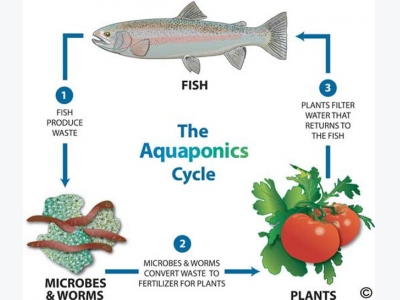Home Aquaponics Build

The build pictures you will see below are for an aquaponics system. Aquaponics is a method of growing vegetables (indoor or outdoor). The system acts as an entirely self sufficient ecosystem that circulates the water through the plants and back into the tank. Essentially the fish eat food, convert that food into waste that dissolves into the water, then the water gets pumped into the grow bed and is absorbed by the growing plants. The water is then cycled back down to the fish tank cleaner than when it arrived.
Here I have attached several pictures of the build process for my home aquaponics system:

Here you can see the frame construction. We bought the 2x4s, sanded them down, and did two coats of stain to help them blend in with the brick of the apartment.

At this stage the 55 gallon fish tank was installed with everything except the fish. The frame was just finished up and dropped over the full tank. As you can see there is a long air-stone in the tank. This is to aerate the water, which is super important in making the dissolved nutrients available to the plants.

Here you see the 4'x2' grow bed made of food grade plastic. On the right you see a small PVC tube sticking out of the plastic. This will be covered by a large PVC tube with a cap that creates an auto-siphon when the water reaches a certain level. This allows the system to automatically fill up and empty out without an extra pump/timer.

At this stage I added three crucial components to the system. The first is the grow medium (hydrocroton - white rock like substrate), which allows the plants to form roots in order to grow. The second thing is the water pump that brings water up from the tank to the grow bed (top left tube). Lastly, I added the grow lights (two 125 watt fluorescents).

The final system in operation!
Related news
 Paper Baskets For Seedlings Instead Of Expensive Peat Pots!
Paper Baskets For Seedlings Instead Of Expensive Peat Pots! In February and March is the time for planting vegetables and summer flowers.
 How Plain Buttermilk Can Fight Off Mildew On Vegetables!
How Plain Buttermilk Can Fight Off Mildew On Vegetables! There is a time of hard work in the garden around the cultivation of the favorite vegetables and, above all, nutrition and disease protection.
 6 Steps How To Soak The Seeds Before Planting Tomatoes!
6 Steps How To Soak The Seeds Before Planting Tomatoes! It is alleged that this way it is possible to increase the yield of tomatoes by one-third. In addition, soaking allows achieving uniform sizing of the shoots.
 Tomato Farming Information Guide
Tomato Farming Information Guide Tomato is a well known fruit/vegetable across the globe. Most of the countries cultivate tomatoes in the world.
 Mint Farming Information Guide
Mint Farming Information Guide Mint is one of the popular herb cultivated for its aroma, culinary use and medicinal properties throughout the world